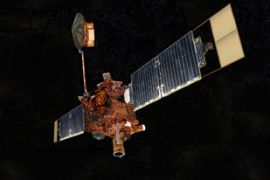Mars Surveyor ‘lost in space’
Nasa scientists lose contact with a spacecraft mapping Mars.

One chance remained on Tuesday to recover the probe, which has been programmed to transmit a signal to Nasa’s robotic geology station, Opportunity, located near Mars’ equator.
Opportunity will relay any signal from the orbiter to Earth during passes on Tuesday and Wednesday via the Mars Odyssey.
“If MGS is in the sky and its [transmitter] is on, then Opportunity should receive it,” John Callas, project manager for the Mars Exploration Rover mission, said.
| “MGS [Mars Global Surveyor] was a fantastic mission. It has really revolutionised how we look at Mars.”
Fuk Li, Mars exploration programme manager at Nasa |
Scientists at Nasa’s Jet Propulsion Laboratory in Pasadena, California, lost contact with the spacecraft on November 2 after it signaled that it was having trouble moving one of its solar panels to track the sun as it emerged from behind Mars.
The spacecraft is programmed to position itself so that a stuck panel faces the sun, but that orientation could block its communication with mission controllers, Tom Thorpe, the Mars Global Surveyor project manager, said.
If Mars Global Surveyor has been turned away from the sun for more than a few orbits of the planet it could have run low on power, an outcome that seemed to be supported by the spacecraft’s apparent failure to respond to commands that would raise its transmitter, Thorpe said.
“We don’t believe the [solar] panel is in any way degraded … the problem seems to be the gimble motor that is sticking,” Thorpe said, “Why we can’t raise the transmitter could be a function of the power problem.”
Mars Global Surveyor’s cameras were the first to record topographic features suggesting flowing water on Mars, and its magnometer found the remains of magnetic fields that once shielded Mars’ surface from deadly cosmic rays.
Its mineral mapping helped scientists choose landing sites for Opportunity and its twin, Spirit, and will be used to evaluate landing sites for the next-generation of Mars surface probes, the Phoenix and the Mars Science Laboratory.
The 10-year mission, which was extended four times, cost a relatively modest $377 million.